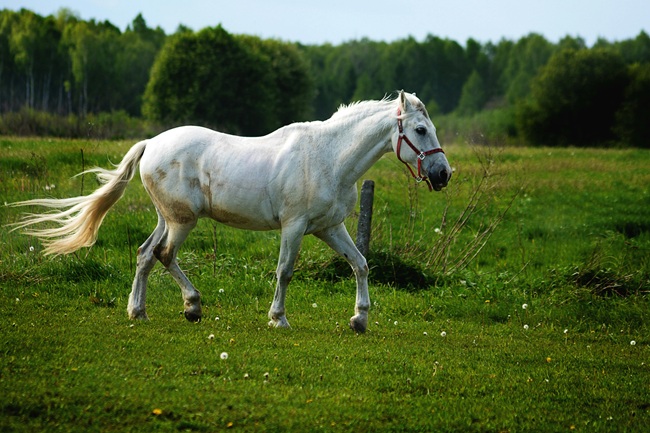
Tails are vital communication centers for your horse, relaying messages about moods, health, energy, and locomotion. Whether wispy or luxurious, flowing, braided, or banged, a horse’s tail is perhaps his most beautiful and versatile physical feature. Much more than mere ornament or glorified flyswatter, the tail serves many purposes. As a device of communication, it speaks simply and eloquently to horse and to man; as a barometer of equine health, it telegraphs vital messages about an animal’s well-being; as a protective shield, it assists in temperature regulation and safeguards delicate reproductive structures against environmental onslaught; and as a mechanism of balance, it subtly influences the alignment of the horse’s hind end.
Why is a structure prized for its aesthetic appeal also a practical appendage? That answer can be found by looking at the anatomy and evolution of the tail. Flexible and strong, the horse’s tail is part of his spinal column. It is made up of approximately 18 vertebrae, some horses have more, others have fewer. The bones are progressively smaller from the root of the tail to the tip; the last one is pointed. Overall tail movement is governed by portions of the semitendinosus muscles, which extend over the horse’s rump and attach to the vertebrae. Detailed adjustments in curvature and posture of the tail are aided by muscle-fiber bundles located in the tail itself, above, below and on each side of the bones. Two arteries pump blood to the tail, but circulation is not efficient in this narrow appendage. As a result, injuries heal more slowly here, and infections tend to persist stubbornly. On the exterior, the skin and hair of the tail are enhanced versions of the horse’s fuzzy hide. For instance, at the point where the tail attaches to the buttocks, the skin is five-eighths of an inch thick–as much as a half-inch thicker than it is anywhere else on the horse. Thicker and coarser than any body hair, the strands of the tail are made entirely of hardened (keratinized) protein.
A typical tail hair consists of three layers; an inner core (medulla); the middle cortex layer comprised of long, twisted protein strands; and a thin protective outer covering known as the cuticle. Through it appears smooth, the cuticle is made of overlapping horny scales. It’s the middle layer that determines whether a hair is curly or straight. The individual protein strands vary in their physical properties, such as how stretchy they are, but usually they are distributed evenly, so that the hair looks straight. However, if too many strands with similar properties are grouped together, the cortex is no longer balanced, and the hair develops waves.
Straight hair generally is the rule among horses, but a few breeds, notably Morgans and some draft horses, can sport wavy tails. The most extreme example of an eccentric cortex is the Bashkir Curly, not only are his tail and mane frizzy, but his body is completely covered in split curls. Some breeds, such as the Andalusian and Friesian, are known for the extraordinary length and luxury of their tails. Like their curly-coated counterparts, these horses possess a specific combination of genes that produce their magnificent tresses. Genetic factors also combine with environmental influences to determine which horses have rough, coarse, protective tail hair–for instance, the dense, heavy tails of Shetland ponies and Icelandic horses and which ones possess fine, silky locks, the desert-roaming Arabian is a prime example.
What no one really knows, though, is why the horse is the only member of the equine family to have such long, flowing locks. His history, however, does hold some clue. In prehistoric oceans, creatures that pushed with their tails to move in straight lines went to the top of the food chain as sharks and other fishes. Amphibians retained powerful propulsive tails even as their ungainly legs emerged. Eons before the equine species existed, land reptiles’ (dinosaurs’) legs protruded from the sides of their heavy bodies. Long, heavy tails were critical to these animals’ ability to get from place to place. They were used as counterbalances for maneuvering around corners and tillers for moving in a straight line. By the time the horse’s early ancestor hyracotherium appeared sometime in the Eocene epoch, the tail already had reached the point of being largely nonfunctional as a locomotor device. Hyracotherium looked and moved in a drastically different way than its ancestors. Its knees were turned forward, its elbows backward and its limbs were tucked under the body. Stuart Sumida, PhD, hypothesizes that the adaptations were related to the survival of the species. “Hyracotherium relied on speed to evade its predators,” he says. “This new type of physique allowed the creature to move more quickly. The importance of the tail as a locomotor device was greatly diminished. It was essentially freed up to become what it is today.”
Compared to the functional abilities of other mammalian tails, the horse’s caudal appendage, according to Sumida, deserves only a so-so rating. It’s far inferior to that of a cat, for example, whose tail is wonderfully dexterous, he says, infinitely expressive and a real asset to the amazing array of bodily convolutions a cat can perform. Given its somewhat diminished importance, then, why was the equine tail retained at all? Deb Bennett, PhD, an expert on equine physiology, speculates that there were two compelling reasons: It was there anyway, and the horse needs it. “Nature has a tendency to retain some evidence of the primitive,” she says. “We see that over and over again in evolutionary processes. Then, too, the horse’s tail does serve some real purposes, protection for one, communication for another.”
Provided by Creatures Corner reader Sarah King
Related Articles & Free Email Newsletter Sign Up
A Steady Hand Makes for a Happier Horse
How to Stop a Horse from Pulling Ahead While Being Lead
Why Horses can Sleep While Standing


Comment here